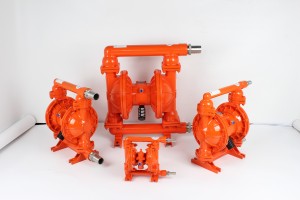The QBK series of aluminum diaphragm pumps is well-regarded. They have a rugged design and are very versatile. As air-operated pumps, they work in many industries. These include chemical processing and wastewater management. They are reliable and efficient. However, to ensure their longevity and optimal function, certain precautions must be observed. This article will outline key points for using the QBK series air-operated diaphragm pumps, especially the aluminum ones.
Specific considerations for the QBK series
The QBK series has specific considerations due to its design and material specifications:
1. Ensure the fluid’s particles meet the pump’s safe passing diameter standard. The exhaust of the air-operated diaphragm pump may contain solids. Do not point the exhaust port at the work area or people to avoid personal injury. This is also very important. Personal safety, you must pay attention to this when using the air-operated diaphragm pump at work.
2. The intake pressure should not exceed the allowable use pressure of the pump. Excessive compressed air may cause injury, damage, and pump failure.
3. Ensure the pump pressure pipeline can withstand the output pressure. Also, ensure the driving gas system is clean and works normally.
4. Static sparks may cause explosions, resulting in personal injury and property losses. Use wires with a large enough cross-section to reliably ground the pump’s screws.
5. Grounding must comply with local laws and site-specific requirements.
6. Tighten the pump and each pipe joint to prevent static sparks from vibration, impact, and friction. Use antistatic hose.
7. Periodically check the grounding system. Its resistance must be under 100 ohms. Regular inspections are vital for pneumatic diaphragm pumps. So, don’t skip them.
8. Maintain good exhaust and ventilation, and stay away from flammable, explosive and heat sources. This is very important, stay away from dangerous goods.
9. When conveying flammable and toxic fluids, connect the outlet to a safe place away from the work area.
10. Use a pipe with a 3/8″ minimum inner diameter and a smooth inner wall to connect the exhaust port and the muffler.
11. If the diaphragm fails, the exhaust muffler will eject the material.
12. Use the pump correctly and do not allow long-term idling.
13. If the pump is used to convey harmful, toxic fluids, please do not send it to the manufacturer for repair. Handle it per local laws. Use genuine accessories to ensure service life.
14. The pneumatic diaphragm pump protects all parts that contact the fluid. It prevents corrosion and damage from the conveyed fluid.
15. Tighten the pump and each connecting pipe joint to prevent static sparks caused by vibration, impact and friction. Use anti-static hose.
16. The high pressure of the pneumatic diaphragm pump fluid may cause serious personal injury and property loss. Please do not pressurize the pump and the material when the pump is pressurized. Do not perform any maintenance work on the pipe system. For maintenance, first cut off the pump’s air intake. Then, open the bypass pressure relief mechanism to relieve the pipe system’s pressure. Finally, slowly loosen the connected pipe joints.
17. For the liquid delivery part, do not use the aluminum alloy pump to deliver liquids with Fe3+ and halogenated hydrocarbons. They will corrode the pump and cause it to burst.
18. Ensure that all operators are familiar with the operation and use and master the safe use precautions of the pump. If necessary, provide the necessary protective equipment.
Conclusion
In summary, the QBK series aluminum diaphragm pump is flexible and high-performing. However, it needs specific precautions for optimal use. Each aspect is key. It includes correct installation, an appropriate air supply, regular maintenance, and ensuring compatibility. These guidelines will help users. They will maximize the life and efficiency of pneumatic diaphragm pumps. They will also ensure consistent, reliable performance.
Post time: Jan-17-2025








